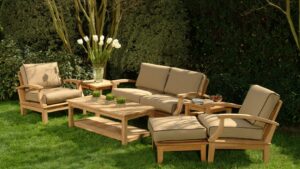As the world grapples with climate change, there’s a growing focus on sustainable living. It’s no longer just about what’s inside the house, but what’s in the garden too. Enter sustainable garden furniture – a perfect blend of style, functionality, and environmental responsibility.
Sustainable Garden Furniture
 As trends evolve, the world witnesses a profound shift towards eco-friendly practices in garden furniture production. Opting for sustainable alternatives diverts waste from landfills, proving beneficial for the environment. Recycled teak, for instance, inhibits excessive logging of virgin forests and stops wood from ending up in waste streams. An example of this is sustainably produced timber seating, which embodies both aesthetic appeal and environmental sensitivity.
As trends evolve, the world witnesses a profound shift towards eco-friendly practices in garden furniture production. Opting for sustainable alternatives diverts waste from landfills, proving beneficial for the environment. Recycled teak, for instance, inhibits excessive logging of virgin forests and stops wood from ending up in waste streams. An example of this is sustainably produced timber seating, which embodies both aesthetic appeal and environmental sensitivity.
Outdoor furniture crafted from plastics recycled from water bottles and milk jugs is another viable option. Polyethylene terephthalate (PET) plastic furniture, for instance, illustrates the efficient use of resources, providing a myriad of design possibilities. Brands like Loll Designs and Polywood showcase PET-based garden furniture that repurposes millions of plastic waste, combatting plastic pollution in a fashionable manner.
Lastly, adopting the “Zero Waste” philosophy in the garden furniture industry maximizes the full utility of materials, minimizing overall waste. Creating pieces from scrap wood or unused industrial products, as shown in designs by Scrapile and Piet Hein Eek, personifies the philosophy.
Evaluating Key Types of Sustainable Garden Furniture
 With a range of options available, three categories dominate the sustainable garden furniture industry – Recycled Plastic, Reclaimed Wood, and Zero Waste Concepts.
With a range of options available, three categories dominate the sustainable garden furniture industry – Recycled Plastic, Reclaimed Wood, and Zero Waste Concepts.
1. Recycled Plastic Furniture: Brands, for instance, Loll Designs and Polywood, capitalize on plastics from waste products like water bottles and milk jugs. They transform this material into stylish and sturdy garden furniture pieces that resist weather effects and require minimal maintenance.
2. Reclaimed Wood Furniture: This type includes pieces handcrafted using wood recovered from old structures, for instance, barns. An example is teak, a highly recycled wood. It’s durable, lends a rustic charm, and prevents further tree cutting for wood.
3. Zero Waste Concepts: The Zero Waste approach, illustrated by Scrapile and Piet Hein Eek, optimizes the use of resources. The goal remains to produce captivating pieces, while keeping waste close to nil.
Maintenance Tips to Extend the Life of Your Sustainable Garden Furniture
Proper care for sustainable garden furniture prolongs its lifespan and optimizes its environmental benefits. Here are the top three maintenance rules:
- Regular Cleaning: Remove debris and dust from furniture surfaces with a soft cloth. For tougher stains on recycled plastic pieces from brands like Loll Designs and Polywood, a solution of mild detergent and water proves effective.
- Protection: Protect wooden furniture, such as those from Scrapile and Piet Hein Eek, by applying a coat of eco-friendly sealant or paint. This minimizes the chances of the wood rotting or deteriorating due to exposure to outdoor elements.
- Repairs: Mend minor damages immediately to prevent escalation. For instance, tighten any loose bolts and, if necessary, consider replacing worn-out parts from the original manufacturer for an exact fit.
These guidelines ensure you maximize the utility of your eco-friendly outdoor space, with sustainable garden furniture standing the test of time.
The Environmental and Economic Impact of Choosing Sustainable Garden Furniture
 Embracing sustainable garden furniture isn’t just about making an aesthetic statement. It’s a commitment to our planet and future generations. Brands like Loll Designs, Polywood, Scrapile, and Piet Hein Eek are leading the charge, turning waste into wonders. They’re proving that style and sustainability can coexist, and that the origin, durability, and design of materials matter.
Embracing sustainable garden furniture isn’t just about making an aesthetic statement. It’s a commitment to our planet and future generations. Brands like Loll Designs, Polywood, Scrapile, and Piet Hein Eek are leading the charge, turning waste into wonders. They’re proving that style and sustainability can coexist, and that the origin, durability, and design of materials matter.
Choosing eco-friendly outdoor pieces isn’t the end of the journey though. Maintenance is key. Regular cleaning, protection with eco-friendly sealants, and prompt repairs keep these pieces looking their best and lasting longer. This not only maximizes the utility of outdoor spaces but also ensures that sustainable garden furniture will stand the test of time.
So, when you sit back in your sustainable garden furniture, you’re not just enjoying the great outdoors. You’re part of a bigger picture, making a difference one recycled plastic chair or reclaimed wood table at a time.

